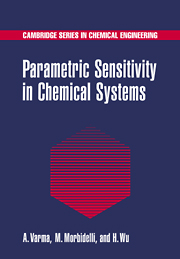Book contents
- Frontmatter
- Contents
- Preface
- 1 Introduction
- 2 Introduction to Sensitivity Analysis
- 3 Thermal Explosion in Batch Reactors
- 4 Runaway in Tubular Reactors
- 5 Parametric Sensitivity in Continuous-Flow Stirred Tank Reactors
- 6 Runaway in Fixed-Bed Catalytic Reactors
- 7 Parametric Sensitivity and Ignition Phenomena in Combustion Systems
- 8 Sensitivity Analysis in Mechanistic Study and Model Reduction
- 9 Sensitivity Analysis in Air Pollution
- 10 Sensitivity Analysis in Metabolic Processes
- Author Index
- Subject Index
1 - Introduction
Published online by Cambridge University Press: 04 May 2010
- Frontmatter
- Contents
- Preface
- 1 Introduction
- 2 Introduction to Sensitivity Analysis
- 3 Thermal Explosion in Batch Reactors
- 4 Runaway in Tubular Reactors
- 5 Parametric Sensitivity in Continuous-Flow Stirred Tank Reactors
- 6 Runaway in Fixed-Bed Catalytic Reactors
- 7 Parametric Sensitivity and Ignition Phenomena in Combustion Systems
- 8 Sensitivity Analysis in Mechanistic Study and Model Reduction
- 9 Sensitivity Analysis in Air Pollution
- 10 Sensitivity Analysis in Metabolic Processes
- Author Index
- Subject Index
Summary
The Concept of Sensitivity
The behavior of a chemical system is affected by many physicochemical parameters. Changing these parameters, we can alter the characteristics of the system to realize desired behavior or to avoid undesired behavior. In general, different parameters affect a system to different extents, and for the same parameter, its effect may depend on the range over which it is varied. By parametric sensitivity, we mean the sensitivity of the system behavior with respect to changes in parameters.
Let us illustrate the concept of sensitivity using some examples. Figure 1.1 shows the effect of changes in the initial temperature on the temperature evolution in a batch reactor for acetic anhydride hydrolysis, measured experimentally by Haldar and Rao (1992). There is a critical change in the temperature profile as the initial temperature increases from 319.0 to 319.5 K. In particular, an increase in the initial temperature by 0.5 K leads to a change in the temperature maximum by about 31 K. This experimental observation indicates that the system temperature becomes sensitive to small variations in the initial temperature in a specific region, called the parametrically sensitive region.
Figure 1.2 shows similar sensitivity phenomena in a tubular reactor obtained by numerical computations, given by Bilous and Amundson (1956) in their pioneering work on parametric sensitivity in the context of chemical reactors. In this example, the ambient temperature of a tubular reactor, where an exothermic reaction occurs, is changed. It is seen in Fig. 1.2a that when the ambient temperature increases by 2.5 K from 335 to 337.5 K, the temperature maximum (hot spot) along the reactor length changes by about 70 K.
- Type
- Chapter
- Information
- Parametric Sensitivity in Chemical Systems , pp. 1 - 8Publisher: Cambridge University PressPrint publication year: 1999



